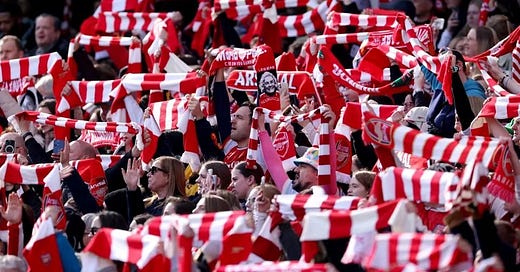Fan culture in women’s football has no doubt had an expanding and diversifying change in recent history. With more eyes on the women’s game than ever before, it’s safe to say that fan culture has been re-defined.
After the Lionesses championed to glory in 2022, lifting the European Championship trophy for the first time in their history, English football took off in a way no one could have expected. Despite the tournament smashing records previously set by the Netherlands in the 2017 Euros, the visibility of women’s football has created change amongst attendance figures and TV viewings right through to the grassroot teams in such a short time. The season after the Lionesses won the Euros, approximately 1,500 new teams were registered under the FA, the BBC finds.
We saw the impact of how winning a tournament on home soil transformed the exposure of the Lionesses and how it inspired little girls and boys to follow in the footsteps of their heros. But we’ve seen this type of success all too well before, with the most decorated team in women’s football: the US Women’s National Team. Their four World Cup Titles and four Olympic Titles prove their international and historical dominance, and for decades have set the example for why they deserve the recognition that they get.
The most recent tournament in women’s football had a record-breaking global reach as well. The Final of the Women’s World Cup, co-hosted by Australia and New Zealand, saw 263 million viewers worldwide, in comparison to the 2019 WWC Final in France that had a TV viewing of only 82 million.
Despite the rapid success and engagement women’s football has been receiving over the past three years, the culture amongst the women’s game has certainly had questionable and interesting changes in recent times. If you ask any women’s football fan, you will know that the environment is friendly, welcoming, and accessible for life-long fans or recently newer fans discovering the game. All you have to do is attend a game and you’ll find out. However, there are some concerns that the profession of women’s football isn’t being taken seriously enough.
The top two leagues in women’s football in England, the Women’s Super League (WSL) and the Women’s Championship, are going to have a change of ownership that will commence in the upcoming 2024/25 season campaign. In November of last year, all 24 clubs unanimously agreed on the creation of a new structure that has been called NewCo, Nikki Doucet as the CEO. Doucet has expressed that she wants the WSL to become the, “most distinctive, competitive and entertaining” women’s soccer league in the world.
However, there have been some controversial comments made by Doucet that have sparked conversation amongst women’s football fans. In an interview with Sky Sports earlier this year in January, Doucet said:
“I think the experience of going to a women’s match, I see it as kind of like Glastonbury. It’s a festival feeling, it’s welcoming, it’s fun, it’s competitive, it’s passionate, and I think people want to be part of that.”
The reaction to these comments was partly frustration and partly intrigue. Women’s football wants to be renowned for its professionalism and fierce competitiveness, but comparing it to a music festival massively takes away from this. On the other hand, the women’s game in modern day football has always had a clear message of being inclusive and accessible for all, regardless of gender, race, background et cetera. And because of this, the narrative for women’s matches have predominantly been marketed as a “family day out”, which is great for the amount of young girls and boys being able to see their favourite Lionesses week in and week out, but the focus of the sport itself has somewhat been lost.
Women’s football fans also feel they have a greater and closer connection to the players, due to the intimate and approachable environments the female players play in. For instance, Arsenal Women played seven of their home league fixtures at Meadow Park, which has a stadium capacity of just 4,500, in the 2023/24 WSL season, and over the years it has become a place where players and fans can bond. Arsenal recently announced that the Women’s Team will play eleven fixtures at the club’s stadium, The Emirates, making it the main home of Arsenal Women. This comes into effect after their highly successful average attendance figure of 52,029 in the six home league fixtures they played at the Emirates. Arsenal fans have expressed that there might be a shift in relationship amongst fans and players, as they move to a ground with 13.5x the stadium capacity than the familiar Meadow Park.
However, fans understand that in order to grow the women’s game, the women’s team playing at the club’s stadium is the best move and ideally this is a step all women’s football clubs strive to achieve.
Photo: https://www.forbes.com/sites/asifburhan/2024/03/03/arsenal-women-average-home-attendances-exceed-35000-for-wsl-season/




